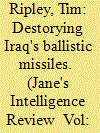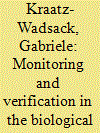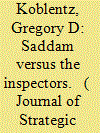| Srl | Item |
| 1 |
ID:
014394


|
|
|
|
|
| Publication |
Oct 1992.
|
| Description |
459-462
|
|
|
|
|
|
|
|
|
|
|
|
|
|
|
|
| 2 |
ID:
012731


|
|
|
|
|
| Publication |
June-July 1997.
|
| Description |
3-6
|
|
|
|
|
|
|
|
|
|
|
|
|
|
|
|
| 3 |
ID:
147681


|
|
|
|
|
| Summary/Abstract |
The multilateral disarmament of Iraq represents the first time since the 1918 Treaty of Versailles that victors in war imposed disarmament upon another country. In many ways, the disarmament efforts of the UN Special Commission on Iraq (UNSCOM) in the 1990s were highly successful, resulting in the discovery and elimination of most of Iraq's biological, chemical, and nuclear weapons programs, as well as their delivery systems. This article discusses the origins of Iraq's weapons of mass destruction, the establishment of UNSCOM, and UNSCOM's operational structures, capabilities, and results, as well as its eventual replacement by the UN Monitoring, Verification, and Inspection Commission—a result of political strife within the body that created it, the UN Security Council.
|
|
|
|
|
|
|
|
|
|
|
|
|
|
|
|
| 4 |
ID:
182968


|
|
|
|
|
| Summary/Abstract |
This article provides a brief overview of the ongoing monitoring and verification (OMV) regime in Iraq in the biological-weapons area. As an integral part of the formal ceasefire arrangement in 1991, the United Nations Security Council established an international verification regime encompassing nuclear, biological, and chemical weapons and some ballistic missiles. The verification regime was built on two mutually supportive pillars. One pillar related to disarmament validation, i.e., verifying that all prohibited weapons, facilities, and related items and certain ballistic missiles in Iraq were destroyed or rendered harmless, and all past weapons-of-mass-destruction (WMD) activities had ceased. The second pillar was ongoing monitoring to continuously verify that non-proscribed activities were not being diverted to reconstitute WMD programs. Biological-weapons disarmament and OMV in Iraq provide an example of an effective system that may serve as a reference point for future efforts.
|
|
|
|
|
|
|
|
|
|
|
|
|
|
|
|
| 5 |
ID:
157893


|
|
|
|
|
| Summary/Abstract |
The discovery that Iraq had no weapons of mass destruction (WMD) in 2003 raised the question of why Saddam had prevented UN weapons inspectors from fully accounting for his disarmament. The leading explanation for Saddam’s behavior is that he valued ambiguity as part of a strategy of ‘deterrence by doubt’. This article argues that Iraq’s obstruction of inspectors in the late 1990s was motivated by his desire to shield Iraq’s regime security apparatus from UNSCOM’s intrusive counter-concealment inspections. The failure to understand how strongly Saddam’s concerns about his personal safety drove Iraq’s contentious relationship with UNSCOM set the stage for the invasion of Iraq in 2003.
|
|
|
|
|
|
|
|
|
|
|
|
|
|
|
|